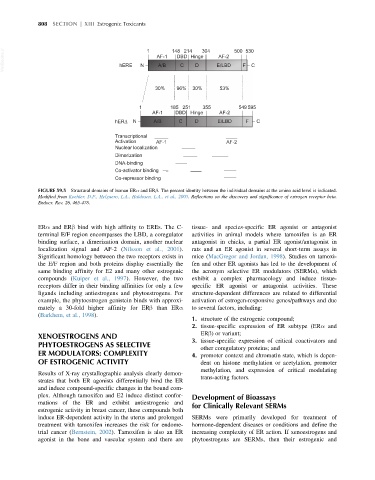Page 850 - Veterinary Toxicology, Basic and Clinical Principles, 3rd Edition
P. 850
808 SECTION | XIII Estrogenic Toxicants
VetBooks.ir hERE N 1 AF-1 148 214 Hinge 304 E/LBD 500 530 C
DBD
AF-2
D
C
A/B
F
30% 96% 30% 53%
1 185 251 355 549 595
AF-1 DBD Hinge AF-2
hERΔ N A/B C D E/LBD F C
Transcriptional
Activation AF-1 AF-2
Nuclear localization
Dimerization
DNA-binding
Co-activator binding
Co-repressor binding
FIGURE 59.5 Structural domains of human ERα and ERβ. The percent identity between the individual domains at the amino acid level is indicated.
Modified from Koehler, D.F., Helguero, L.A., Haldosen, L.A., et al., 2005. Reflections on the discovery and significance of estrogen receptor beta.
Endocr. Rev. 26, 465-478.
ERα and ERβ bind with high affinity to EREs. The C- tissue- and species-specific ER agonist or antagonist
terminal E/F region encompasses the LBD, a coregulator activities in animal models where tamoxifen is an ER
binding surface, a dimerization domain, another nuclear antagonist in chicks, a partial ER agonist/antagonist in
localization signal and AF-2 (Nilsson et al., 2001). rats and an ER agonist in several short-term assays in
Significant homology between the two receptors exists in mice (MacGregor and Jordan, 1998). Studies on tamoxi-
the E/F region and both proteins display essentially the fen and other ER agonists has led to the development of
same binding affinity for E2 and many other estrogenic the acronym selective ER modulators (SERMs), which
compounds (Kuiper et al., 1997). However, the two exhibit a complex pharmacology and induce tissue-
receptors differ in their binding affinities for only a few specific ER agonist or antagonist activities. These
ligands including antiestrogens and phytoestrogens. For structure-dependent differences are related to differential
example, the phytoestrogen genistein binds with approxi- activation of estrogen-responsive genes/pathways and due
mately a 30-fold higher affinity for ERβ than ERα to several factors, including:
(Barkhem, et al., 1998).
1. structure of the estrogenic compound;
2. tissue-specific expression of ER subtype (ERα and
XENOESTROGENS AND ERβ) or variant;
3. tissue-specific expression of critical coactivators and
PHYTOESTROGENS AS SELECTIVE
other coregulatory proteins; and
ER MODULATORS: COMPLEXITY 4. promoter context and chromatin state, which is depen-
OF ESTROGENIC ACTIVITY dent on histone methylation or acetylation, promoter
methylation, and expression of critical modulating
Results of X-ray crystallographic analysis clearly demon-
trans-acting factors.
strates that both ER agonists differentially bind the ER
and induce compound-specific changes in the bound com-
plex. Although tamoxifen and E2 induce distinct confor- Development of Bioassays
mations of the ER and exhibit antiestrogenic and for Clinically Relevant SERMs
estrogenic activity in breast cancer, these compounds both
induce ER-dependent activity in the uterus and prolonged SERMs were primarily developed for treatment of
treatment with tamoxifen increases the risk for endome- hormone-dependent diseases or conditions and define the
trial cancer (Bernstein, 2002). Tamoxifen is also an ER increasing complexity of ER action. If xenoestrogens and
agonist in the bone and vascular system and there are phytoestrogens are SERMs, then their estrogenic and

